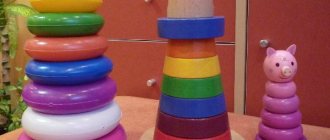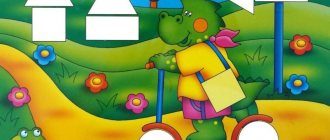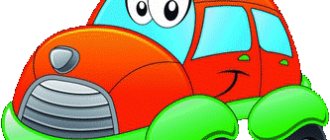CARD FILE OF GAMES FOR FORMING A HEALTHY LIFESTYLE (middle group)
Transcript
1 CARD FILE OF GAMES FOR FORMING A HEALTHY LIFESTYLE (middle group) Prepared by: Preschool teacher. group 9 Yurchenko K.A.
2 Game “Pack a backpack for a hike” CONTENTS: The goal is to consolidate children’s knowledge of what a person needs for a hike; cultivate composure and accuracy. Game rules: name objects after raising your hand, name objects without shouting or interrupting each other, collect accessories when given a signal, carefully. Equipment: Dunno toy, two backpacks, items for the hike: compass, matches, dummies of fruits and vegetables, map, bottled water, ball, newspaper, disposable tableware; hairdryer, nesting doll, paints, etc. “What is planted in the garden” - teach children to classify objects according to certain characteristics (according to the place of their growth, according to the method of their use, develop quick thinking, auditory attention, speech skills. Game rule. Answer the driver’s questions you only need the words “yes” or “no". Game action. Whoever makes a mistake gives a forfeit, which he then wins back. Progress of the games: The teacher asks: “Children, do you know what they plant in the garden? Let’s play this game: I "I will name different objects, and you listen carefully. If I name something that is planted in the garden, you answer “yes,” but if something that does not grow in the garden, you say “no.” Whoever makes a mistake loses." Carrots. Children. Yes! Educator. Cucumbers. Children. Yes! Educator. Beets. Children. Yes! Educator. Plums. Children. No! If someone rushes and answers incorrectly, the teacher can say: “You will make people laugh in a hurry. Be careful!” “I can - I can’t” Goals: to focus children’s attention on their skills and the physical capabilities of their body; develop self-esteem. Equipment: ball. The presenter throws the ball and says: “I
3 I can” or “I can’t.” The child, having caught the ball, continues the phrase, explaining why he can or cannot do it. For example: “I can run because I have legs. I can't fly because I don't have wings." “Hygiene rules” Goal: to consolidate cultural and hygienic skills (washing, dressing, brushing teeth, combing one’s hair, bathing), to develop the ability to show these movements using facial expressions and gestures and to guess by showing them. Progress of the game: The teacher asks the children, using facial expressions and gestures, to show how they wash themselves (dress, brush their teeth, etc.), observing the sequence of performing these skills. Or the teacher shows with the help of facial expressions and gestures what he is doing, and the children guess. “Guess the riddle from the picture” Goals: to help children remember the main group of dangerous objects, to develop attention. Equipment: pictures depicting dangerous objects. An adult asks a riddle, and children guess and find the corresponding picture. An adult asks you to think and say why these objects are dangerous? Children tell what danger each object poses. “Find dangerous objects” Objectives: to help children remember objects that are dangerous to life and health; help you draw your own conclusions about the consequences of not handling them carefully. Equipment: knife, scissors, needle, iron. Andryusha and
4 Natasha. Their parents went to work. Let's tell the kids what objects they can't use so that trouble doesn't happen. Children repeat the safety rules: All sharp, piercing, cutting objects must be put back in their place; Do not turn on electrical appliances; they may cause electric shock or cause a fire; Under no circumstances should you try medicine; it is poison; You cannot try washing powders, dishwashing detergents, soda, bleach; It is dangerous to go out onto the balcony alone. “Healthy and harmful products” Purpose: to systematize children’s ideas about harmful and healthy products, to exercise the ability to differentiate them, to form the need to take care of their health Material: pictures depicting various products, two hoops Progress of the game: in order to be healthy, you need to do it correctly eat. Now we will find out if you know which foods are healthy. The teacher offers the children pictures using two hoops. In one hoop, children select healthy foods and explain their choice, in the second, foods that are harmful to them. “Journey to the Land of Health.” Goal: to strengthen children’s ideas about how to help themselves and others always stay healthy. Equipment: playing field with pasted illustrations; cube, colored chips or buttons. The players take turns throwing a die on the sides of which there are 1 to 3 circles depicted, and move their
5 chip forward as many moves as circles appear on the die. If the chip is on the red circle, then the child, before making the next move, must answer how to behave in case of a runny nose, cough, high temperature, or toothache. If the answer is incorrect, the child skips a move; if the answer is correct, he makes the next move. When the chip ends up on the green circle, the player tells how movement, daily routine, vitamins, and water treatments are beneficial for a person. If the answer is incorrect, the child skips a move; if the answer is correct, the child moves the chip forward three moves. The winner is the one who gets to the land of health first. “You are a part of me” Goal: to systematize children’s ideas about body parts, develop speech, attention, memory. Material: ball Game progress: the teacher throws the ball to each child, asking a question. I am a face, you are a part of me. Who are you? (eyes, eyebrow, nose, etc.) I am the head, you are my part. Who are you? (hair, ears) I am the body, you are my part. Who are you? (back, stomach...) “Remember the movement” Purpose: to exercise the ability to realize, remember and reproduce the shown movements, to develop visual-motor memory and attention. Progress of the game: the teacher or child shows the movements. Children must remember and reproduce them.
6 “If someone is sick” “The game is a serious matter” “Mushroom picking” Purpose: to consolidate the knowledge that in case of a serious injury it is necessary to call an ambulance doctor by calling “103”, to practice calling a doctor Material: telephone Game progress: If we ourselves cannot cope with the situation, then we call a doctor or an ambulance. Children are encouraged to call a doctor at home. First, dial the phone number and call it in order: last name, first name > address > age > complaints. Goal: to train children in choosing safe objects for games based on pictures, to consolidate knowledge of what objects can be played with. Material: pictures depicting various objects (dangerous and non-dangerous), two hoops Progress of the game: The teacher invites the children to arrange the pictures into two hoops. In one hoop, children select pictures depicting objects that can be played with, in the second, pictures depicting objects that cannot be played with, and explain their choice. Goal: to consolidate knowledge of edible and inedible mushrooms, the ability to distinguish them by appearance in pictures and dummies. Material: pictures or dummies of edible and inedible mushrooms Game progress: place the pictures or dummies in different places. Children are invited to collect edible mushrooms in a basket. “My day” Objectives: talk about the daily routine; learn to explain and prove your point of view; teaches you to find violations of patterns in a sequential series. Equipment: 3-4 sets of cards with images of different regime moments. You need to arrange the cards
7 sequentially, in accordance with the schedule (from getting up in the morning to going to bed in the evening), explain to the children why the cards should be laid out this way and not otherwise. Option 1. Competition “Who can lay out a row faster?” Option 2. “Continue the row.” The teacher begins to lay out the sequence, and the child continues. Option 3. “Correct the mistake.” The teacher lays out the entire sequence of cards, breaking it in one or more places, the children find and correct the mistakes. “Our Helpers Plants” Goal: to consolidate ideas on how to help yourself and others always stay healthy. Equipment: subject pictures depicting medicinal plants. The game is played according to the lotto principle; children have cards with images of medicinal plants. The teacher shows pictures with similar drawings. A child who has this plant talks about its use for treatment. If correct, gets a picture. The one who closes his card first wins. “On a walk” Purpose: to consolidate knowledge about correct behavior and communication with animals, to correlate what is shown in the pictures with correct and incorrect actions when meeting animals Material: illustrations, 2 hoops Progress of the game: several pictures lie face down on the table. The child chooses any, examines and
8 tells: what is depicted on it, whether the child is acting correctly or incorrectly here. Or put pictures in one hoop depicting the correct actions when meeting animals, and in the other with incorrect actions. “Dunno Came to Us” Goals: to teach children to take care of the cleanliness of their bodies, the neatness of their clothes; “The Journey of a Breadball”; teach to see the implausibility of the proposed situation, its absurdity. Equipment: Dunno doll, chips, briefcase with incentive prizes. Children listen carefully to Dunno's story, and as the story progresses, they notice fables and mark them with chips. At the end of the story, the teacher asks the children to count how many fables each of them noticed, then the children explain the mistakes they noticed in Dunno’s story. Children must work independently and not interfere with their friends; inconsistency of the child is punishable by a penalty point. A child who notices all the fables, is active in the game and does not receive a single penalty point is awarded an incentive prize. Objectives: talk about the path that food takes in the human body, explain the need for thorough chewing. Equipment: table with a schematic representation of the human digestive system, bread ball. Children roll the ball across the table and repeat after the teacher the name of the organs of the digestive system. “What the traffic light says” Goal: to consolidate knowledge about the meaning of the colors of the traffic light and the rules of behavior on the street. Material: colored cardboard circles (red, yellow and green), traffic light model. Progress of the game: the teacher distributes red, yellow and green mugs to the children. Consistently “switch”
9 traffic lights, and the children show the corresponding circles and explain what each signal means. The winner is the one who correctly shows all the circles and talks about the purpose of the colors. “What the traffic light says” Goal: to consolidate knowledge about the meaning of the colors of the traffic light and the rules of behavior on the street. Material: colored cardboard circles (red, yellow and green), traffic light model. Progress of the game: the teacher distributes red, yellow and green mugs to the children. The traffic lights are sequentially “switched”, and the children show the corresponding circles and explain what each signal means. The winner is the one who correctly shows all the circles and talks about the purpose of the colors.





